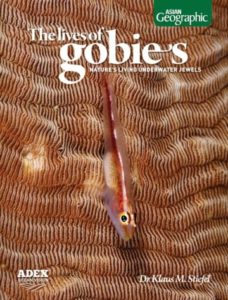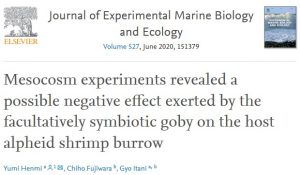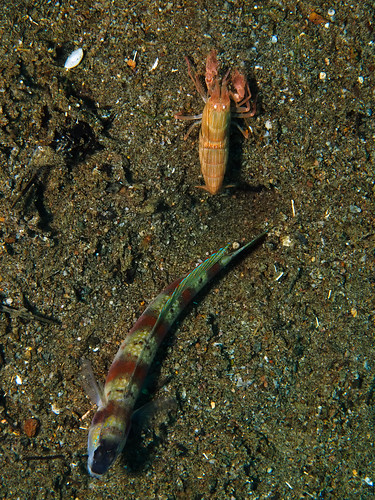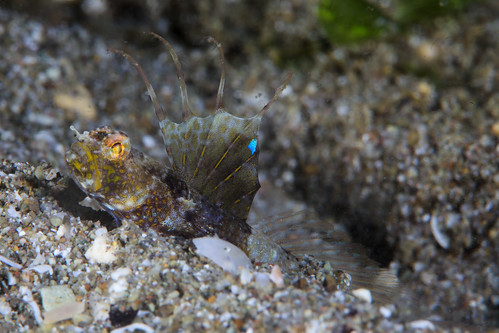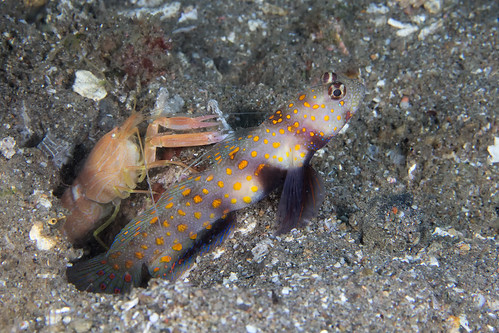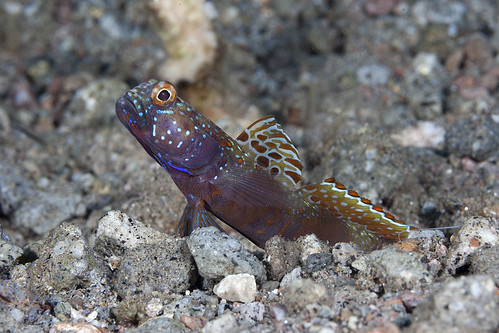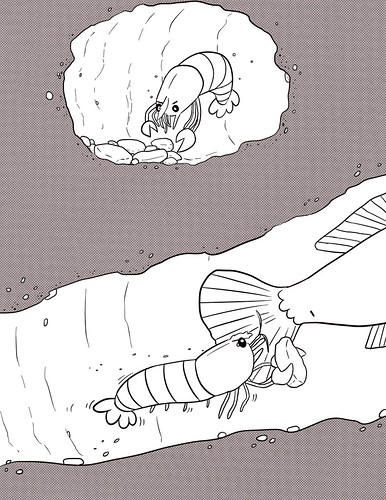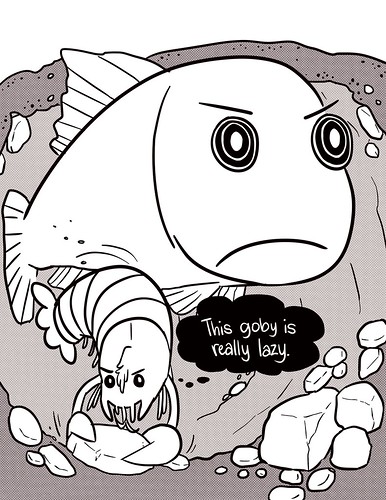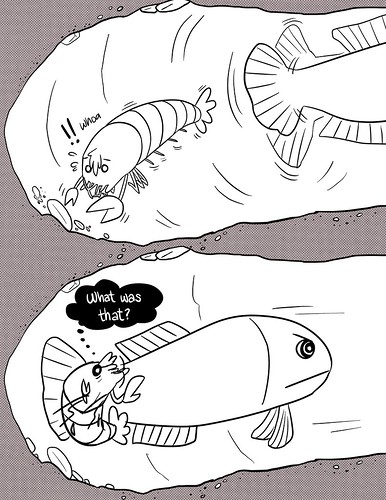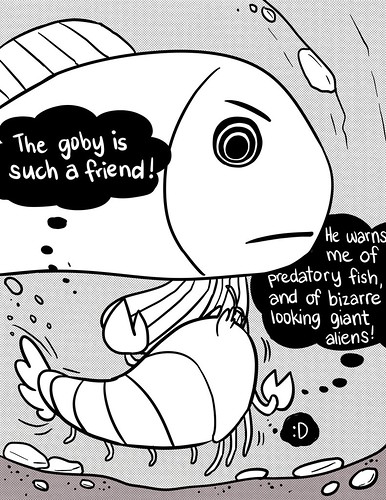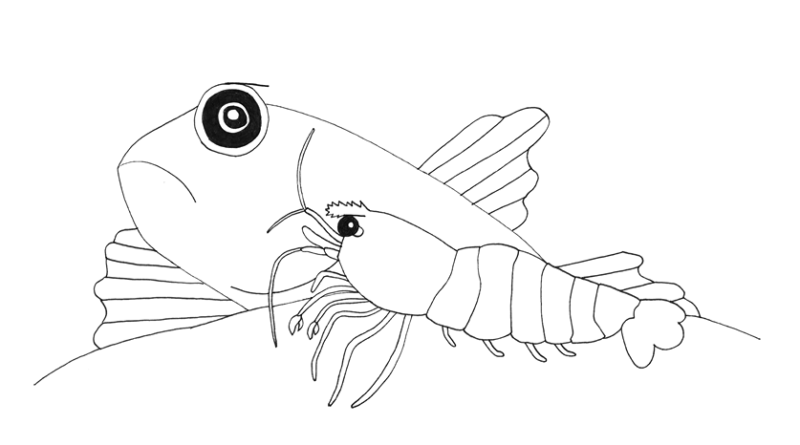
The Shrimp Goby Page
Shrimp gobies are small marine fishes of the family gobiidae which live in a symbiosis with alpheid shrimp. In this symbiosis, the shrimps (usually a couple) dig a burrow which they share with the fish. The shrimp are not completely blind, but have poor vision, and are hence are very vulnerable when they leave the burrow to forage on the surface of the sandy areas where the pair lives. Here the goby comes in: it has excellent eye sight for such a small animal, and keeps watch for predatory fishes. When one such fish approaches somewhat closely, the goby gives the shrimp a tactile warning signal by wiggling its tail. The shrimp understand and does not leave the burrow for a while. When a dangerous large fish approaches very closely, the goby quickly flees into the burrow, and both the fish and the crustacean hide underground for a couple of minutes.
In this way, two small animals have become very successful by working together, the shrimp as a construction worker, and the goby as a watchman. They could settle the otherwise featureless , dangerous sandy planes next to coral reefs, which offer no coral fingers or sponge cervices for small animals to hide, like the reef does. The gobies alone would be too weak to dig burrows, and the shrimp would not see predators approaching when above ground. This page aims to introduce this fascinating symbiosis to biologists and interested lay netizens. Please check back, since we will be updating and expanding frequently.
Many thanks to the Marine Science Institute of the University of the Philippines, which is my goby science home base, to the nice people from Two Photon Art who sponsored this page with a science communication grant, and to the guys at Evolution Diving who collaborated with me on our survey of the gobies of Malapascua/Cebu/Philippines.
Images – Videos – Shrimp Goby Comics – More About Shrimp Gobies – Lecture – Links
News
News in March 2024: New observations of goby bobbing, a social signal between the fish:
News in January 2024: I am back to shooting videos of gobies, and shrimp gobies, and on the academic side, my friend Abner Bucol and I are trying to publish this manuscript on the lower size limit of vertebrates. That’s of course highly relevant for gobies, which are among the smallest vertebrates.
News in March 2023: I released a full-length documentary about “muck diving”, the sandy habitats where the shrimp-goby symbiosis is often taking place. The documentary has a chapter about “symbiosis”, with mention of the shrimp-goby pair, the video below is set to start with that chapter:
News in November 2022: I found a nice page on Wild Singapore (which I just had the chance to visit!) on the shrimp-goby symbiosis.
New in October 2022: I am happily doing lots of diving, filming and underwater photographing in Negros Island these days. One of my recent finds was this fish of the genus Drombus, which seems to be a shrimp goby:
New in October 2021: The Lives of Gobies, my popular science book (for an interested lay audience) about all things gobies will be published with Asian Geographic, and is on pre-sale now.
New in May 2021: We published a new study about the changes in brain connectivity which could give rise to the communication system between shrimps and gobies. Many thanks to my co-authors for this interesting project!
Landsittel, J. A., Ermentrout, G. B., & Stiefel, K. M. (2021). A computational model of the shrimp-goby escape and communication system. Journal of Computational Neuroscience, 1-11.
Here you can read the paper online for free.
And here is a more detailed popular science account of what we found.
I also made a video about our findings, with ace goby footage. Enjoy!
New in September 2020: A diving friend sent me some of his photos of the Caribbean shrimp goby Nes longus, a species which has been studied by several groups. The Caribbean has facultative shrimp gobies, which show a weaker association with their alpheid shrimp; However Nes longus sticks to its shrimp as tightly as the Indo-Pacific shrimp gobies, and is used as a positive control in studies of this symbiosis in the Caribbean.
New in April 2020: A very interesting paper by Hemmi et al. on the trade-offs experienced by the shrimp in the symbiosis: IF the shrimp is reared together with a goby, it’s burrows are restricted in size, and don’t scale with shrimp size anymore.
New in June 2018: I compiled some of my footage showing the shrimp-goby communication system, and wrote a blog post about Randall’s Shrimp Goby, the king of shrimp gobies in my opinion.
Images
The gobies and shrimps are not just engaged in an intriguing symbiosis, but they are also very photogenic small animals, especially the gobies. These small fishes’ fins and bodies are decorated with brilliant colors, and some species also have gaudily elongated fin spines to communicate with other gobies of the same species. Since the goby’s main job is to watch out for predators, these are extremely shy and skittish animals, and it takes a very calm underwater photographer to approach them without making them flee into their burrow.
This is a classic image, showing the shrimp-goby couple from above. Dauin, Negros Island, Philippines. I love the dark sand in Dauin for underwater photography. The shrimp stands out really well. It will not stay in this spot for very long. Usually, after bulldozing a spoon full of sand out of the burrow, and maybe picking up a piece of seaweed to feed on, it would hurry right back underground.
A very rare and beautiful shrimp goby of the species Tomiyamichthys latruncularius. Anilao, Batangas, Philippines.
Also from Dauin: Amblyeleotris guttata, proudly watching over its shrimp. You can see how the shrimp keeps its antenna on the goby when on the surface, to be able to detect any warning signals (tail flicks) the goby might pass on.
A Cryptocentrus, again from Dauin. The shrimp is underground. If you click on the images, you’ll be taken to Flickr, where you can see more of my shrimp goby pictures.
Videos
Just as it is a challenge to take pictures of shrimp gobies, it is also not easy to shoot them on video. A trick which I often use is to place my camera in front of the burrow, press the record button, and swim away…
This is a mini-documentary I shot in Palawan, in the western Philippines.
The next video shows some of the shrimp gobies I have observed in Bolinao (where the University of the Philippines Marine Science Institute’s Marine Lab is), in the Pangasinan province on the west coast of Luzon, the main large island in the north of the Philippines (where Manila is located). I am quite excited about some of the close ups I got of these very small fish. Why are they making these odd, upward-jerking movements? No one knows! Also: I am a bit on a crusade against boring music in underwater videos.
This video I filmed with the spectacular Inon bug-eye lens, which allows me to get close focus, but a wide-angle view at the same time. The location is Dauin, Negros Island, Philippines, the goby is Cryptocentrus fasciatus. And there is a special guest in the video, an animal of scary size (if you are a goby)….
This video I shot in Bolinao as well. I am really excited about the super-slow motion of the goby escapes which are featured in it, and about the macro shot of the eye color change of a goby over the course of a few minutes. I love my Olympus E-M1 with the 60 mm macro lens, it’s a freakin’ underwater field microscope!
Shrimp Goby Comics
We have succeeded in getting up-and coming Filipina artistas, Ms. Gera Guinto and Ms. Alex Villarino to depict the trials and tribulations of the shrimp and its goby. Here and only here – the shrimp goby cartoon:
More About Shrimp Gobies
If the images and videos of shrimp gobies have captured your imagination so far, and you would like to learn more about this symbiosis, then this is the section for you. I will give a brief review of the current state of knowledge about shrimp gobies and shrimps, with my personal take on the topic.
What is the Role of the Goby in the Symbiosis?
The goby is looking out for predatory fishes, which pose a danger for both fish and shrimp, due to their relatively similar size. While the shrimp is not blind, its eyesight is poor and it would not recognize an oncoming danger in time. Small carnivores like wrasses, gropers and sandperches (known to feed heavily on alpheid shrimp, Sano, 1993) are the main threats the pair faces. The goby communicates the fact that danger is approaching to the shrimp, and both hide in the shared burrow.
There are reports that the goby can distinguish between herbivores (not dangerous), and carnivorous fishes (dangerous!). Gobies would ignore small fishes, always escape from large fishes, but distinguish mid-sized fishes according to diet (Karplus & Thompson, 2011).
How does the Goby Communicate with the Shrimp?
The communication system between the goby and the shrimp is tactile. Whenever the shrimp leaves the shared burrow, it touches the goby with one of its antennae. The contact usually happens on the dorsal or caudal fins of the fish, or on its tail. A quick tail flick of the goby means “orange alert” to the shrimp, a quick escape into the burrow is a “red alert” and tells the shrimp that a predator is right within striking distance. In this way the goby can communicate its visual observations about the environment to the shrimp.
What is the Role of the Shrimp in the Symbiosis?
The shrimp, or, in most cases, a pair of shrimps, dig a burrow which serves as a hide-out for both animals when a predator approaches. The burrow reach 10s of centimeters underground, depending on the composition of the ground. Shrimp seem to prefer a mix of sand and gravel for burrow construction (Palomar et al., 2005). The burrows have chambers, side tunnels, and often incorporate rocks or coral blocks as ceilings. The entrance of the burrow often shifts around on a daily basis. At night the shrimp closes the burrow entrance, and both partners remain underground.
How do they Find each other?
There seems to be choice involved by both partners of this symbiotic dance: the goby visually gauges the size of a burrow’s entrance, and the markings on the body of the shrimp. The shrimp decides from olfactory cues if the goby species is right for him or her. A “wrong” goby is blocked from entering the burrow.
Only certain combinations of shrimp and goby species are possible, as determined by the evolutionary position of the species and their ecological specialization (Thompson et al., 2013).
Where does this symbiosis occur?
Gobies occur from the intertidal zone, where mudskippers spend extended periods on land in-between the mangrove roots, to depths below 1000 meters. Shrimp gobies occur in the upper part if that range, from shallow seagrass meadows (< 1 meter) to depths of about 50 meters . Fishbase also does not list a species belonging to a known shrimp-goby genus as occurring deeper than 50 meters (Stiefel & Reyes, 2018). In years of technical diving in the Philippines I have not seen a single shrimp goby deeper than 50 meters (Stiefel et al., 2014). If anyone has observations to the contrary, I would love to hear about them!! Is there not enough light anymore at depth for the gobies to work reliably as watchmen?
The goby-shrimp symbiosis is restricted to tropical and subtropical oceans. In three years of diving in the Sydney area (warm temperate oceans – Sydney is located at 33° South) I have not seen a single shrimp goby, even though they are supposed to range that far south and I am on the outlook for these animals. It is an interesting question what limits the occurrence of shrimp gobies to warmer oceans, since there are ample goby species further north in colder waters. Is it that the increased predation pressure in the tropics makes the symbiosis between shrimps and gobies necessary, while cooler water gobies can fend for themselves without a shrimp providing a burrow? Or does the sparsity of sunlight during winter have to do with it?
How Many Species of Shrimp Gobies are there?
There are about 120 species of shrimp-associated gobies. Interestingly, the symbiosis has evolved twice, in closely related by independent clades of gobies, the reef shrimp gobies and the silt shrimp gobies (Thacker et al., 2011). Many species of gobies are photophobic (they tend to move away from light), and many hide in burrows, which they sometimes dig themselves (Valencienna) or in any type of hole or crevice which they can find. Several species of Trimma tend to hover upside-down in crevices on the face of steep reef walls. With the tendency of gobies to hide in holes, the eagerness of alpheid shrimps to dig holes, and the great benefit of the symbiotic cooperation, it is in hindsight not surprising that the symbiosis evolved twice.
A species of goby in the Caribbean, Ctenogobius saepepallens, lives with alpheid shrimp in a facultative relationship: the goby is not paired with one burrow and one (pair of) shrimps, but uses shrimp burrows for escape as the need arises (Lyons, 2013). This is an interesting intermediate stage to the full obligate symbiosis between shrimps and gobies.
References
There is a wealth of very interesting literature on the topic of the shrimp – goby symbiosis, this is a subjective selection of it, mentioned in the paragraphs above. The review by Karplus and Thompson is a great place to start reading.
Lyons, Patrick J. “The benefit of obligate versus facultative strategies in a shrimp–goby mutualism.” Behavioral ecology and sociobiology 67.5 (2013): 737-745.
Karplus, Ilan. “The tactile communication between Cryptocentrus steinitzi (Pisces, Gobiidae) and Alpheus purpurilenticularis (Crustacea, Alpheidae).” Zeitschrift für Tierpsychologie 49.2 (1979): 173-196.
Karplus, I., R. Szlep, and M. Tsurnamal. “Goby-shrimp partner specificity. I. Distribution in the northern Red Sea and partner specificity.” Journal of Experimental Marine Biology and Ecology 51.1 (1981): 1-19.
Karplus, I. “Goby-shrimp partner specificity. II. The behavioural mechanisms regulating partner specificity.” Journal of Experimental Marine Biology and Ecology 51.1 (1981): 21-35.
Karplus, Ilan, and Andrew Richard Thompson. “The partnership between gobiid fishes and burrowing alpheid shrimps.” The biology of gobies. Science, Boca Raton, FL (2011): 559-608.
Palomar, Nadia E., Marie Antoinette Juinio-Meñez, and Ilan Karplus. “Behavior of the burrowing shrimp Alpheus macellarius in varying gravel substrate conditions.” Journal of Ethology 23.2 (2005): 173-180.
Sano, Mitsuhiko. “Foraging activities and diets of males and females in a haremic sandperch (Pisces: Pinguipedidae).” Marine ecology progress series. Oldendorf 98.1 (1993): 55-59.
Stiefel, Klaus M., and Rodolfo B. Reyes. “The marine goby–alpheid shrimp symbiosis does not correlate with larger fish eye size.” bioRxiv (2018): 329094.
Stiefel, Klaus M., et al. “A comparison of the gobiid fauna between a shoal and an island habitat in the central Visayas (Philippines).” bioRxiv (2014): 006049.
Thacker, Christine E., Andrew R. Thompson, and Dawn M. Roje. “Phylogeny and evolution of Indo-Pacific shrimp-associated gobies (Gobiiformes: Gobiidae).” Molecular phylogenetics and evolution 59.1 (2011): 168-176.
Thompson, Andrew R., et al. “Ecology and evolution affect network structure in an intimate marine mutualism.” The American Naturalist 182.2 (2013): E58-E72.
Me Lecturing about Shrimp Gobies
This is a lecture I gave about our research of the shrimp-goby symbiosis at the University of the Philippines Marine Science Institute in August 2018:
Links
This is an article I wrote for Scubadiverlife about the love of gobies, Gobyphilia. And for Evolution diving’s Blog I wrote about our study of the gobies of Malapascua. For Hakai Magazine, I wrote about marine life on barren sandy planes, which of course also includes shrimp gobies.
Fishbase is a fantastic resource for all things goby, here is the page with the overview of the family gobiidae, and this is the first of several pages with each species listed with an image. Lots of pretty little fishes!
The Australia Museum also has a lot of nice information about fishes, including gobies.
Robert A. Patzner has a page about Mediterranean gobies with good information.
An excellent photo page with gobies from New Caledonia, the gobies are split up according to genera, please scroll down. In French, but you get the idea of course.
